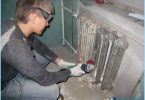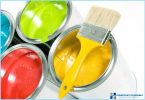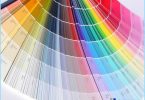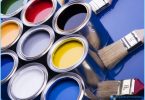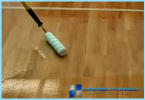The contents
- Variety of colors
- Features alkyd compositions
- Overview of silicate compositions
- Features of emulsion paints
- Adhesive mixture
- How to choose paint for the kitchen
- The choice of shades for the kitchen
- On the technology of drawing on the walls of vodoemulsionki
- Painting alkyd compositions
- The options for wall design
- The specifics of applying texture paint
Many property owners don’t know what paint to choose for walls in the apartment, I liked the result. When choosing paint you must take into account the specifics of the room, also valued aesthetic appeal refinishing.
In order for the paint for the walls was chosen correctly, we propose to understand the varieties of colors.
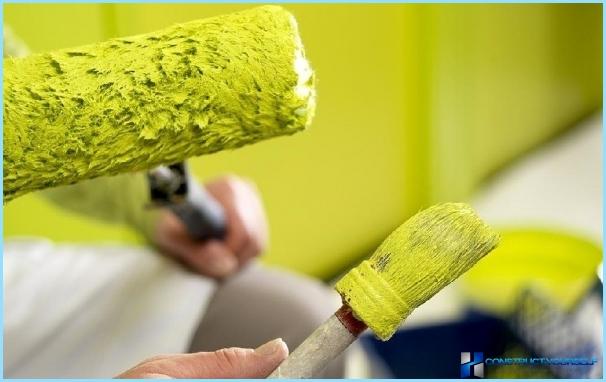
Variety of colors ↑
In Vogue for interiors frequently changing priorities, designers seeking to implement their creative ideas are new materials. There are several types of paint for walls
depending on the basics:
- alkyd;
- silicate;
- adhesive;
- emulsion.
Features alkyd compositions ↑
These include oil paint for walls, made from natural linseed oil. Similar compounds are used for all interior and exterior work. Painting oil compositions is carried out using a roller or brush. It can be used to decorate the plastered walls, concrete, and metal surfaces.

The advantages of alkyd formulations:
- water resistance;
- lightfastness;
- sustainability
- aesthetics.
Disadvantages:
- instability to alkali;
- fire.
For diluting paints, you can use turpentine, linseed oil, white spirit.
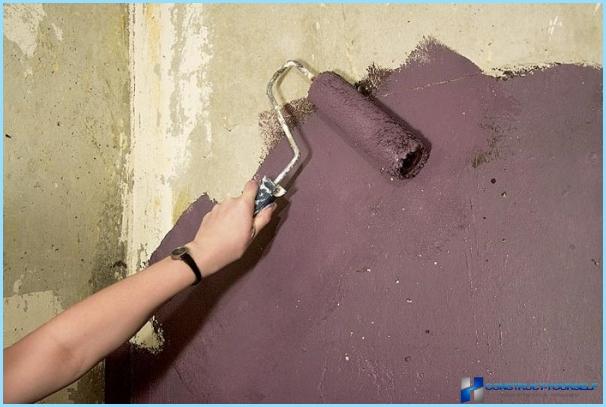
Overview of silica compounds ↑
Silicate mineral paints think, for their production using molten glass. Fillers are talc and chalk separated. Calcium borate or zinc oxide function of silicatization. When added to a mixture of mineral pigments, you can get the desired color. They are intended to protect against ignition of wooden structures.
Advantages:
- looseness;
- breathability;
- resistance to differences of temperatures;
- water vapour barrier;
- excellent adhesion;
- resistance to UV radiation;
- resistance of the coating to the processes of decay.
Disadvantages:
- the instability of a high humidity;
- a significant amount of paint.
These mixtures can be used for decorating concrete, stone, plastered walls inside and outside the building. The average service life of such coatings is 10 years. The transparency of such coatings has made them popular in the manufacture of stained glass. For dilution of the silicate mixture will need regular water. Modern silicate mixture includes acrylic additives, so before paint work, it is important to thoroughly mix them. Apply the mortar to the surface using brush or roller construction.
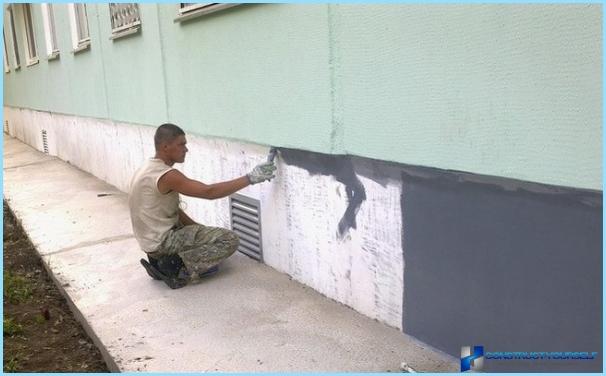
Especially emulsion paints ↑
Modern latex paint for walls and ceilings is classified into types:
- latex;
- latex;
- polyvinyl acetate;
- acrylic;
- latex.
Painting walls with latex paint in the kitchen, even beginners, just need to follow the instructions offered by the manufacturers of vodoemulsionki.
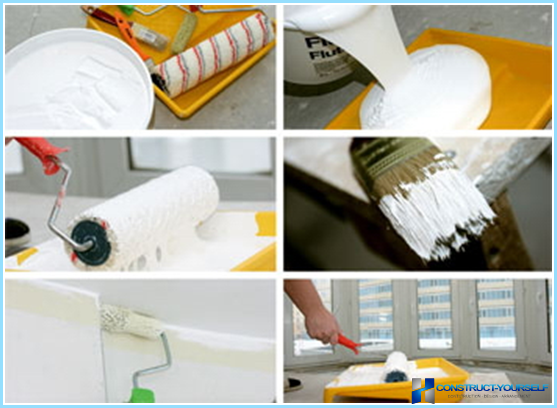
Advantages:
- toxicity;
- resistance to negative chemical substances.
- fire safety;
- quick drying (2-4 hours)
The you have to flush with plain water, it is used for the internal repairs of residential and office space.

Elasticity and strength have acrylic compositions in which the binder level used acrylic resin. The coating is withstand frost, suitable for indoor design.
The disadvantages include the high cost.
Silicone mixture of a silicone resin, is used in interior and exterior paint work. High-quality silicone wall paint is a great choice when decorating kitchens.
Positive characteristics:
- water vapor permeability;
- breathability;
- high aesthetic performance;
- significant operational life
Of all the varieties of water-based mixtures the maximum value of is latex paint for the walls. Its composition is latex, so the drying speed is 20-60 minutes.
Polyvinyl acetate paints you can pick up on latex or latex-based.
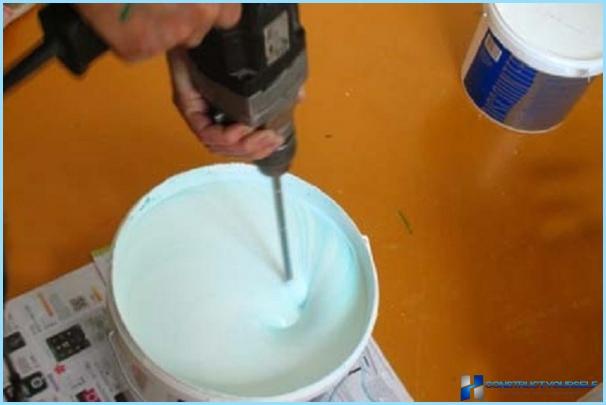
In the manufacture of such mixtures of aqueous dispersion of polymeric substances. The popularity of the mixtures due to their characteristics:
- the lack of toxicity;
- fire safety;
- ease of use
Exactly these colors in a large assortment on the domestic construction market. For complete drying of the painted surface just 2-3 hours.
Emulsions suitable for suitably primed concrete, wood, plastered surfaces.
Adhesive mixture ↑
They are made on the basis of aqueous solutions of organic polymers:
- starch;
- casein;
- polyvinyl alcohol;
- cellulose ether
Characteristics similar to the properties of emulsion paints, but for wet areas such materials are not suitable.
How to choose paint for the kitchen ↑
It all depends on what effect you want to obtain. Paint must be resistant to high humidity, to communicate well with finishing putty.
Finnish Tikkurila paints a surprising variety of colors. For children’s spaces perfect paint Joker created on acrylate binder component. In organic solvents, so the mixture dries quickly, is non-allergenic paint. White matte paint Tikkurila is able to withstand 5000 washes with a stiff brush, is perfect for decorating walls in kitchens, closets, sleeping room. It can be used on wood, cardboard, brick, concrete.
- In the process of drying of alkyd paints an unpleasant odor. They may contain substances that pose a danger to the inhabitants of the kitchen. Such dye mixtures are best used in ventilated areas. Aesthetic appearance of the finished coating similar to expensive ceramic tile. If you choose pastel colors, you can arrange the kitchen in style hi – tech or modern.
- Among vodoemulsionki for kitchen select silicone or acrylic blends, which will be accentuated by a matte texture putty. Acrylic compositions with a special connecting components are ideal for decorating small kitchens. Silicate paint for the walls in the kitchen will suit the owners of city apartments who dream of glossy walls and ceiling. In the ratio the prices and qualities of the ideal choice is a silicate paint.
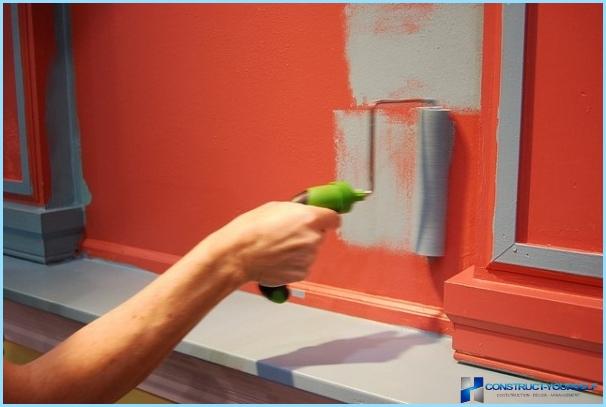
The choice of shades for the kitchen ↑
After selection of the type of coverage, you need to take seriously the selection of its color. The coloring composition should have a high resistance to the negative impact of ultraviolet radiation (does not fade during use). Self-painting walls with latex paint with a pattern is performed strictly according to instructions. There are several «secrets» the choice of color of walls for kitchen:
- no «flashy colors» for a small kitchen;
- furniture and walls should complement each other;
- the coating is chosen taking into account the working apron.
Modern technique of painting walls with acrylic paints guarantees a durable paint finish. Applied three layers:
- alkyd;
- latex;
- alkyd.
On the technology of drawing on the walls of vodoemulsionki ↑
- On the walls in the kitchen a water-based composition is applied in 2-3 layers. First movement of a roller should be horizontally surface, then vertically. ?Attention! A new layer should be applied to the surface only after the previous has dried.
- Before apply the mixture, you need to prepare the wall. To remove the old paint from the walls, you can arm yourself with a spatula, grinder, knife, special washes for paint. All the bumps and cracks primed, shpaklyuem.
Painting alkyd compounds ↑
- The initial layer put a star by selecting the center of the wall point. Roller trying to capture the entire wall surface.
- The second layer deals upwards vertically. When applying another layer, disposable cushion vertically. A new layer is applied only after the previous coat dries.
After you choose the type of paint, choose colors, explore the technology of painting, without much effort you will change the appearance of your kitchen.
To find the optimal color and selecting the very Foundation that you like, you can easily transform the look of your kitchen. Painting the walls is really simple and great fun if you invite friends to visit for repair. Often read the instructions on the can and use only quality paint – excellent result will not keep itself waiting long. I hope these tips will help you paint the walls in the kitchen with their hands and turn the «delicious» room in beautiful and cozy.
Options for the design of walls ^ the
For many years it was the painting of the walls is a leader in modern repair. Textured paint for walls is applied with a special roller helps to obtain an interesting variant of the surface. Before you put it on the wall, it is important to prepare for such a surface procedure.
- Remove old paint, fixing cracks and bumps, put a layer of plaster. Primer increases adhesion, reduces paint consumption mix, align the walls and ceiling. Full drying time is 4-5 hours.
- Textured paint is similar to the plaster, means that the embossed surface. The mass has a high density, and therefore can eliminate minor defects, obtaining a perfect surface.
- From the texture of the foundations of the original white color, adding color, it is possible to obtain the desired shade.
Advantages of textured paint:
- the resistance of the finished surface to wear;
- resistance to ultraviolet rays;
- excellent breathability;
- moisture
The specifics of applying texture paint ↑
After drying of the primer, you can move on to coating the surface of textured material. We offer the following algorithm:
- On the spatula apply a small amount of textured material, place it on the wall or on the ceiling.
- Using a notched roller, a stencil on the wall creates the desired texture.
- After 2-3 hours the composition will stick to the wall after 1.5 – 2 hours the mixture has dried completely. Next, cover the surface with acrylic, decorative wax, or a protective varnish.
- Armed with a conventional brush with stiff bristles or a cloth, it is possible to achieve the desired effect.


